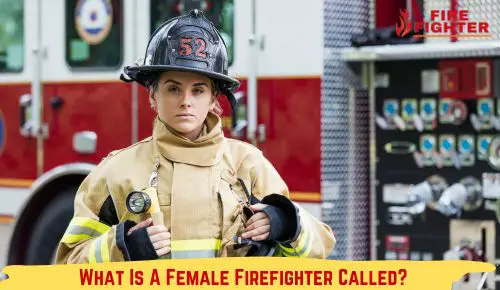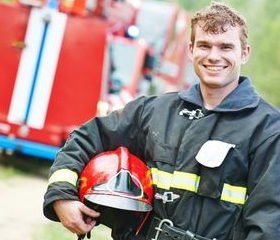What Is A Female Firefighter Called?
When we think of firefighters, we often have a certain image in our heads – strong, brave men rushing into burning buildings to save lives and put out fires.
However, the reality is that firefighting is a profession that welcomes individuals of all genders. In fact, more and more women are joining the ranks of firefighters every year.
But have you ever wondered what a female firefighter is called?
The answer might surprise you. In this blog, we’ll explore the terminology used to refer to women in firefighting and delve into the history of women in this male-dominated field.
Contents
What Is A Female Firefighter Called?
In fact, using the term female firefighter can be seen as unnecessary and even discriminatory since it highlights the gender of the individual instead of their professional skills and qualifications.
The term firefighter describes individuals trained and equipped to respond to emergencies, including fires, accidents, and natural disasters.
Firefighters work in teams to extinguish fires, rescue people and animals, provide medical aid, and maintain community safety.

While the job title of firefighter is gender-neutral, it is essential to recognize women’s challenges in this profession.
Firefighting is a physically demanding job that requires strength, agility, and endurance.
Women may face greater challenges in meeting the physical requirements of the job due to differences in body composition and strength compared to men.
However, this does not mean women cannot excel in this profession.
With proper training and support, women can become excellent firefighters and contribute to the safety of their communities.
Challenges Faced By Women In Firefighting
Gender stereotypes and biases: Firefighting has long been associated with physical strength and endurance, leading to gender stereotypes that portray firefighting as a male-dominated profession.
Women often face biases and misconceptions that they are not as capable or suitable for the physically demanding nature of firefighting.
Discrimination and harassment: Female firefighters have historically faced discrimination and harassment in the workplace.
This can include unequal treatment, exclusion from certain duties or assignments, and even sexual harassment or assault.
Discrimination and harassment can create a hostile work environment for women in firefighting, making it difficult for them to thrive and advance in their careers.
Lack of representation and role models: The underrepresentation of women in firefighting can create challenges for female firefighters, as they may lack role models or mentors who can understand and support their unique experiences in the field.
The lack of representation can also perpetuate gender biases and stereotypes, making it harder for women to be accepted and respected in the firefighting community.
Limited access to training and equipment: Women in firefighting have faced challenges in accessing training programs and equipment designed for male firefighters.
This can include ill-fitting protective gear or uniforms, inadequate facilities, and training programs not tailored to female firefighters’ needs.
These challenges can impact the safety and effectiveness of women in the field.
Balancing work and family responsibilities: Like in many other professions, female firefighters may face challenges in balancing work and family responsibilities.
Firefighting often involves long hours, irregular shifts, and time away from home, which can be particularly challenging for women who may have caregiving responsibilities or face societal expectations of traditional gender roles.
Despite these challenges, many female firefighters have overcome barriers and significantly contributed to the profession.
Their resilience, determination, and dedication have helped pave the way for more women to enter firefighting and break down gender barriers in the field.
What Is The Job Of A Female Firefighter?
The Job of a Female Firefighter: Duties, Responsibilities, and Skills
Firefighting is a physically demanding and crucial profession that involves responding to fires, rescuing people and animals, providing emergency medical care, and preventing and mitigating fire-related incidents.
The job of a female firefighter is no different from that of a male firefighter, as both genders are expected to perform the same duties and responsibilities.
Female firefighters are highly skilled and trained professionals who work alongside their male counterparts to protect their communities and save lives.
Duties and Responsibilities of Female Firefighters:
Responding to emergencies: Female firefighters are trained to respond to various emergencies, including fires, hazardous materials incidents, medical emergencies, and rescue operations.
They work as part of a team to assess the situation, coordinate efforts, and execute the appropriate response strategies to mitigate the emergency.
Fire suppression: Female firefighters are responsible for extinguishing fires using various firefighting techniques, such as operating fire hoses, setting up ladders, and using firefighting tools and equipment.
They work in high-stress environments, often wearing heavy protective gear, to contain and extinguish fires safely and efficiently.
Search and rescue: Female firefighters are trained in search and rescue techniques to locate and extract individuals who may be trapped or injured in emergency situations.
This can involve navigating through smoke-filled environments, climbing structures, and using specialized tools and equipment to extricate victims.
Emergency medical care: Female firefighters are often trained as emergency medical technicians (EMTs) or paramedics and provide medical care to individuals in need.
This can include administering first aid, performing CPR, and stabilizing patients until they can be transported to a medical facility.
Fire prevention and inspection: Female firefighters are responsible for conducting fire inspections and educating the public on fire safety and prevention measures.
They inspect buildings and facilities for fire hazards, ensure compliance with fire codes and regulations, and recommend fire prevention strategies.
Skills of Female Firefighters:
Physical fitness: Like their male counterparts, female firefighters must maintain excellent physical fitness to perform the physically demanding tasks of firefighting, including lifting heavy equipment, climbing ladders, and navigating through challenging environments.
Technical skills: Female firefighters are trained in the use of firefighting tools and equipment, such as fire hoses, extinguishers, cutting tools, and ventilation devices.
They also receive training in emergency medical care, including CPR, first aid, and other life-saving techniques.
Teamwork and communication: Female firefighters work as part of a team, and effective communication and teamwork are essential for their success.
They must communicate clearly and efficiently with team members, follow commands, and coordinate efforts in high-stress situations to ensure the safety of all involved.
Problem-solving and decision-making: Female firefighters must be able to think critically and make quick decisions in emergencies.
They need to assess complex situations, evaluate risks, and determine the most effective strategies to mitigate the emergency and protect lives and property.
The Importance Of Using Inclusive Language
The Importance of Using Inclusive Language in the Firefighting Profession
Language plays a significant role in shaping our perceptions and attitudes toward individuals of different genders, races, ethnicities, and backgrounds.
In the firefighting profession, the use of inclusive language is essential to promote diversity, equity, and inclusion.
It reflects a commitment to treating all firefighters with respect and recognizing their contributions, regardless of their gender or other characteristics.
Here are some key reasons why using inclusive language is important in the firefighting profession:
Promotes gender equality: Using inclusive language, such as “firefighter,” instead of gender-specific terms like “fireman” or “firewoman,” promotes gender equality in the firefighting profession.
It recognizes that men and women can perform the same duties and responsibilities and have equal capabilities in firefighting.
It helps break down gender stereotypes and promotes a more inclusive and diverse work environment where everyone feels valued and respected.
Fosters inclusivity and diversity: Inclusive language acknowledges and respects firefighters’ diverse identities and backgrounds.
It promotes inclusivity by being inclusive of all genders, races, ethnicities, and other characteristics.
It helps create a welcoming and inclusive work culture where all firefighters feel included and respected regardless of their background or identity.
It also sends a positive message to potential recruits from diverse backgrounds that they are welcome in the firefighting profession.
Reflects modern and progressive values: The use of inclusive language in the firefighting profession reflects modern and progressive values that promote equality, diversity, and inclusion.
It demonstrates a commitment to adapting to societal changes and evolving language norms.
Using outdated or gender-specific terms can be perceived as insensitive or exclusionary, whereas using inclusive language shows an understanding of and respect for the diverse world we live in today.
Enhances communication and professionalism: Inclusive language promotes effective communication and professionalism within firefighting.
Using inclusive language helps avoid miscommunication or misunderstandings related to gender-specific or outdated terminology.
It ensures that all firefighters, regardless of their gender, feel respected and valued in their workplace.
It also aligns with the professional and respectful image firefighters want to project to the public and their communities.
Sets an example and promotes change: Fire departments and organizations that use inclusive language in their policies, procedures, and communication set an example for others and promote positive change in the firefighting profession.
By adopting inclusive language, they demonstrate their commitment to promoting diversity, equity, and inclusion and encouraging others to follow suit.
It helps create a more inclusive culture and fosters a sense of belonging for all firefighters.
What It Takes To Be A Female Firefighter
Being a female firefighter requires a unique set of skills, qualities, and characteristics. It takes determination, physical strength, mental resilience, and a passion for serving others.
Here are some key points on what it takes to be a female firefighter:
- Determination and passion for serving others.
- Meeting the same rigorous training and qualification standards as male firefighters.
- Completing firefighting academies and gaining certifications.
- Maintaining physical fitness and strength.
- Excellent teamwork and communication skills.
- Problem-solving abilities and the ability to work under pressure.
- Resilience, adaptability, and perseverance in a male-dominated field.
- Breaking gender stereotypes and challenging societal norms.
- Advocating for inclusivity and diversity in the firefighting profession.
- Combining physical abilities, mental toughness, and a commitment to making a difference in the community.
- These qualities and skills are essential for any individual, regardless of gender, aspiring to become a firefighter and serve their community with dedication and professionalism.
Conclusion
Using inclusive language, such as “firefighter,” promotes gender equality and inclusivity in firefighting.
By adopting gender-neutral language, providing education and training, leading by example, fostering an inclusive culture, and advocating for change, we can create a more welcoming and respectful work environment for all firefighters, regardless of gender.
Let us continue to promote diversity and inclusivity in firefighting through inclusive language and actions that reflect modern values and promote positive change.

Hi, I m Aaron Smith, a firefighter, and creator of Firefighterline.com, a website that provides top-notch training courses for firefighting organizations. After completing my studies, I quickly rose through the fire service ranks, eventually becoming Captain at one of the busiest fire departments in the state.
